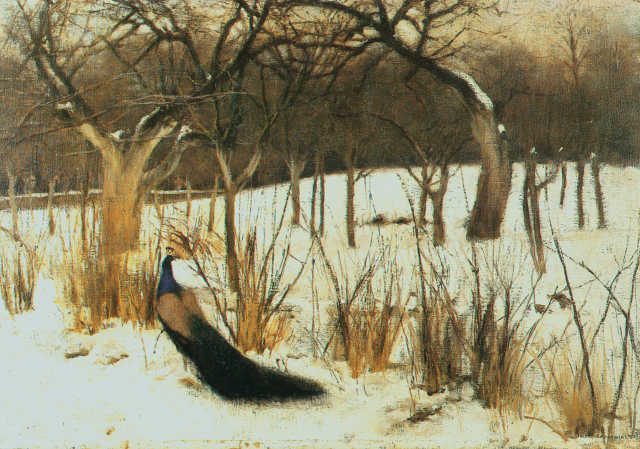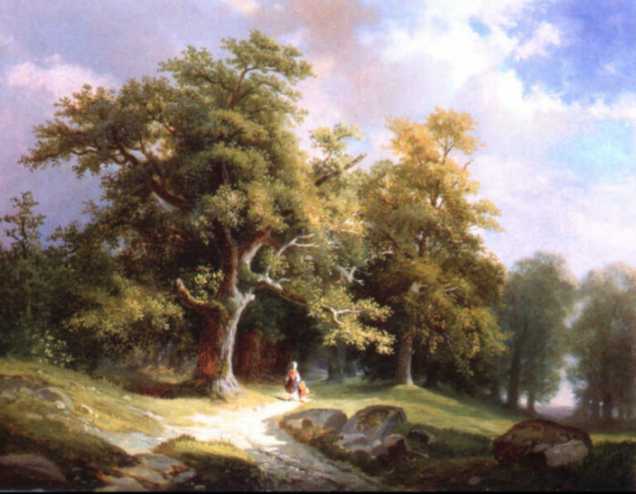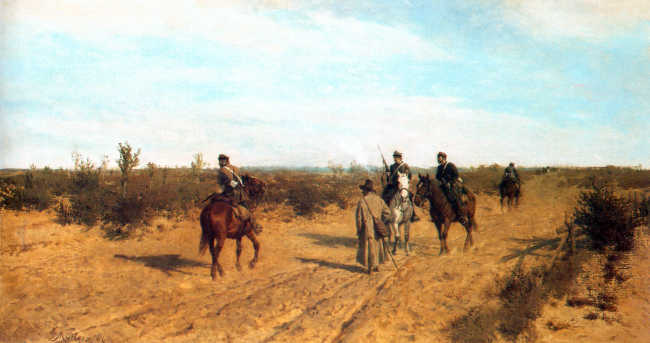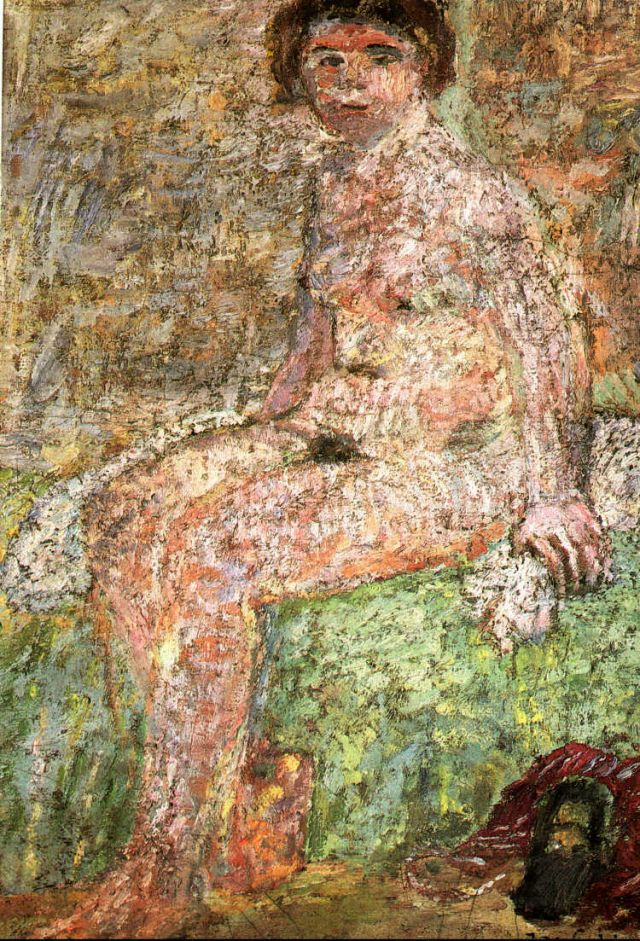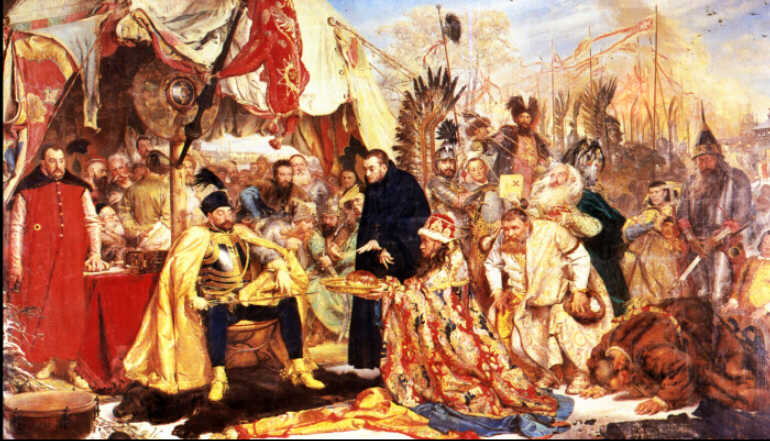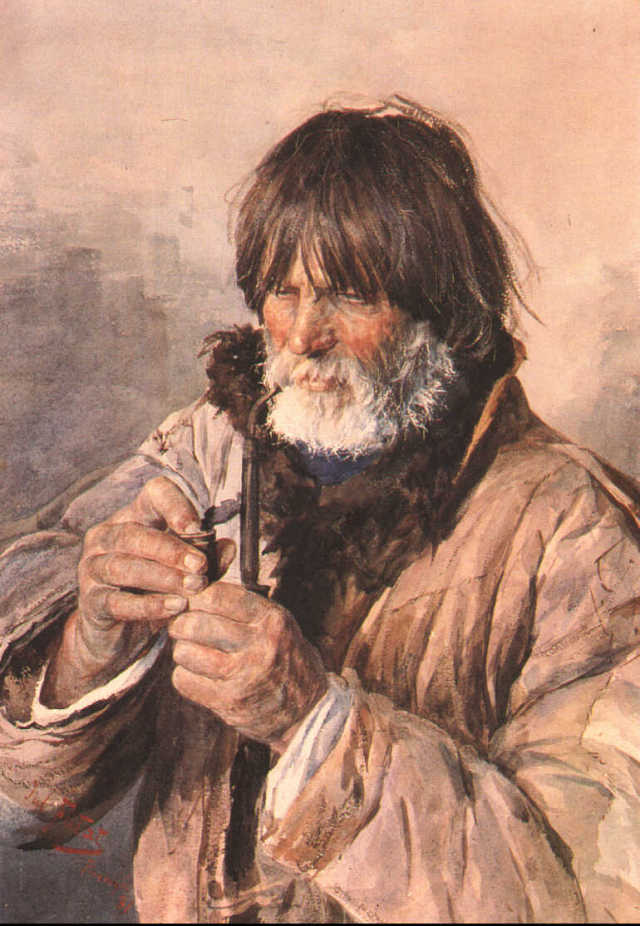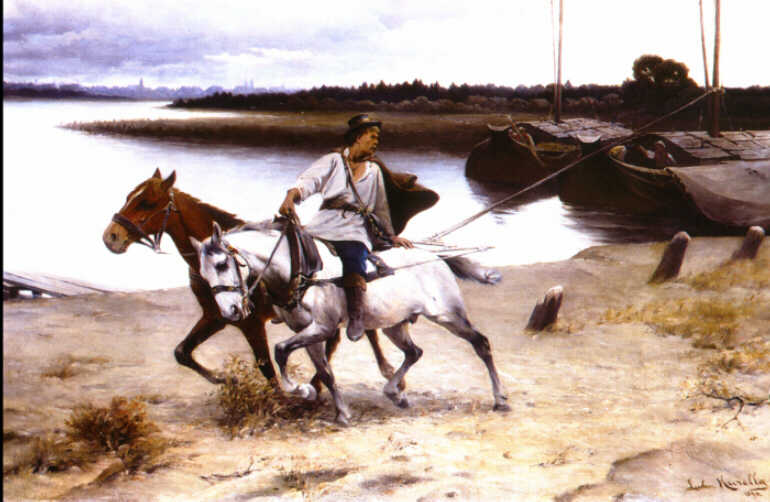Jacek Malczewski (ur. 1854 Working, zm. 1929 Cracow).
He was the most prominent representative of modernism in Polish culture at the turn of the 19th and 20th centuries, and through his painting poetics one of the main co-creators of the legend of Young Poland and the native symbolism of painting of the Young Poland period. Jack's father, Julian Malczewski instilled in the young artist an interest in history and literature. The Bible, mythology and Polish romantic literature, creativity in particular Juliusz Słowacki, they contributed significantly to the atmosphere of the house, remaining important sources of inspiration for the artist's later painting work. The events of the January Uprising left a strong mark on the boy who was less than ten years old 1863 year, stimulating in his imagination the emergence of patriotic and freedom threads, which he gave a pictorial expression throughout his creative life. The artist's stay for several years had a great influence (1867-1871) in the noble court of his uncle Feliks Karczewski in Wielgie, where he studied with his cousins under his care Adolf Dygasiński ( 1839-1902). In August 1871 year he came to Krakow. In the St.. Jacek at ul. Sienna's talent was recognized by a 6th grade teacher, Mr. Siedlecki, and it was through him that Malczewski found himself learning drawing to Leona Piccarda, and then to Jan Matejko , who persuaded his father to let his son Jacek quit his high school education and enter the School of Fine Arts. W 1874 Jacek Malczewski won the 1st prize for antique drawing, 2nd prize for long-term work, award for an academic record. Thanks to his extraordinary talent and great diligence, Malczewski in 1876 with Matejko's consent, he left for Paris, do School of Fine Arts (Schools of Fine Arts) and was admitted to the prestigious French Prix de Rome. The Rome Prize gave artists the opportunity to go to Italy for a longer time and study the art of antiquity and painting of the Italian Renaissance, including, for example, such masters of anatomy in plastic arts, how Luca Signoreli, Antonio Pollaiuolo, Leonardo da Vinci, Michelangelo, Veronese, Titian.
It must be mentioned here, that it was in Italy in the fifteenth century that the first so-called. peeling (eacute;corch eacute;s, Muscle man), that is, anatomical models, depicting the human body stripped of its skin to show the muscles. From then on, the greatest achievements of European figural art were associated with an in-depth knowledge of anatomy. It was no different in the case of Malczewski. It is significant, that, like Michelangelo, he was friends with the famous anatomist Realdo Colombo, yes, and Jacek Malczewski was friends with professor Kazimierz Kostanecki, anatomem, and with professor Napoleon Cybulski, physiologist. These contacts probably contributed to Malczewski's drawing a series of anatomical drawings . The relationship between art and science was good for painting (knowledge of human structure), and medicine (creating anatomical atlases). Thanks to the knowledge of Malczewski's anatomy – realist “served” Malczewski – symbolist and faunist. Almost from the very beginning of his work in Paris, Malczewski takes up Polish-patriotic themes, unable to detach emotionally from the tradition in which he grew up. It was this national tradition with its romantic-patriotic theme that prevented him from accepting the artistic novelties then appearing in Paris., made it difficult to establish contacts with the innovative artists working there at the time. The burdens borne from Poland did not allow him to fully absorb the artistic novelties proclaiming the absolute primacy of color and form, impression, pure impression above the theme and narrative. On the Seine, he begins to create paintings and drawings that take up subjects inspired by his work Juliusz Słowacki, in particular Mazepa, Weneda i Anhellim. Already at the beginning 1877 there are works devoted to the fate of Polish post-uprising exiles to Siberia. Soon, the artist leaves Paris unexpectedly, by autumn 1877 return to the Krakow class Jan Matejko, where it will last up to 1879 year. In the following years, already as an independent artist, he undertakes a series of journeys: to Italy (1880 together with Prince Marceli Czartoryski), to Greece and Asia Minor (1884 with the archaeological expedition of Karol Lanckoroński), Munich (1885-1886). The theme of Siberia and the themes of the life and fate of the exiles will accompany the artist's work from his stay in Paris for many decades.. Significant images Z Sybiru, At the stage, Exiles, Christmas Eve in Siberia, Death of Ellenai they will be created by the end of the first decade of the 20th century. This work is exceptionally rich both formally and thematically.
He was the most prominent representative of modernism in Polish culture at the turn of the 19th and 20th centuries, and through his painting poetics one of the main co-creators of the legend of Young Poland and the native symbolism of painting of the Young Poland period. Jack's father, Julian Malczewski instilled in the young artist an interest in history and literature. The Bible, mythology and Polish romantic literature, creativity in particular Juliusz Słowacki, they contributed significantly to the atmosphere of the house, remaining important sources of inspiration for the artist's later painting work. The events of the January Uprising left a strong mark on the boy who was less than ten years old 1863 year, stimulating in his imagination the emergence of patriotic and freedom threads, which he gave a pictorial expression throughout his creative life. The artist's stay for several years had a great influence (1867-1871) in the noble court of his uncle Feliks Karczewski in Wielgie, where he studied with his cousins under his care Adolf Dygasiński ( 1839-1902). In August 1871 year he came to Krakow. In the St.. Jacek at ul. Sienna's talent was recognized by a 6th grade teacher, Mr. Siedlecki, and it was through him that Malczewski found himself learning drawing to Leona Piccarda, and then to Jan Matejko , who persuaded his father to let his son Jacek quit his high school education and enter the School of Fine Arts. W 1874 Jacek Malczewski won the 1st prize for antique drawing, 2nd prize for long-term work, award for an academic record. Thanks to his extraordinary talent and great diligence, Malczewski in 1876 with Matejko's consent, he left for Paris, do School of Fine Arts (Schools of Fine Arts) and was admitted to the prestigious French Prix de Rome. The Rome Prize gave artists the opportunity to go to Italy for a longer time and study the art of antiquity and painting of the Italian Renaissance, including, for example, such masters of anatomy in plastic arts, how Luca Signoreli, Antonio Pollaiuolo, Leonardo da Vinci, Michelangelo, Veronese, Titian.
It must be mentioned here, that it was in Italy in the fifteenth century that the first so-called. peeling (eacute;corch eacute;s, Muscle man), that is, anatomical models, depicting the human body stripped of its skin to show the muscles. From then on, the greatest achievements of European figural art were associated with an in-depth knowledge of anatomy. It was no different in the case of Malczewski. It is significant, that, like Michelangelo, he was friends with the famous anatomist Realdo Colombo, yes, and Jacek Malczewski was friends with professor Kazimierz Kostanecki, anatomem, and with professor Napoleon Cybulski, physiologist. These contacts probably contributed to Malczewski's drawing a series of anatomical drawings . The relationship between art and science was good for painting (knowledge of human structure), and medicine (creating anatomical atlases). Thanks to the knowledge of Malczewski's anatomy – realist “served” Malczewski – symbolist and faunist. Almost from the very beginning of his work in Paris, Malczewski takes up Polish-patriotic themes, unable to detach emotionally from the tradition in which he grew up. It was this national tradition with its romantic-patriotic theme that prevented him from accepting the artistic novelties then appearing in Paris., made it difficult to establish contacts with the innovative artists working there at the time. The burdens borne from Poland did not allow him to fully absorb the artistic novelties proclaiming the absolute primacy of color and form, impression, pure impression above the theme and narrative. On the Seine, he begins to create paintings and drawings that take up subjects inspired by his work Juliusz Słowacki, in particular Mazepa, Weneda i Anhellim. Already at the beginning 1877 there are works devoted to the fate of Polish post-uprising exiles to Siberia. Soon, the artist leaves Paris unexpectedly, by autumn 1877 return to the Krakow class Jan Matejko, where it will last up to 1879 year. In the following years, already as an independent artist, he undertakes a series of journeys: to Italy (1880 together with Prince Marceli Czartoryski), to Greece and Asia Minor (1884 with the archaeological expedition of Karol Lanckoroński), Munich (1885-1886). The theme of Siberia and the themes of the life and fate of the exiles will accompany the artist's work from his stay in Paris for many decades.. Significant images Z Sybiru, At the stage, Exiles, Christmas Eve in Siberia, Death of Ellenai they will be created by the end of the first decade of the 20th century. This work is exceptionally rich both formally and thematically.
W atelier (The interior of the studio), ok. 1890
oil, canvas, 137 x 108 cm;
signed p.g.: Olga Boznańska;
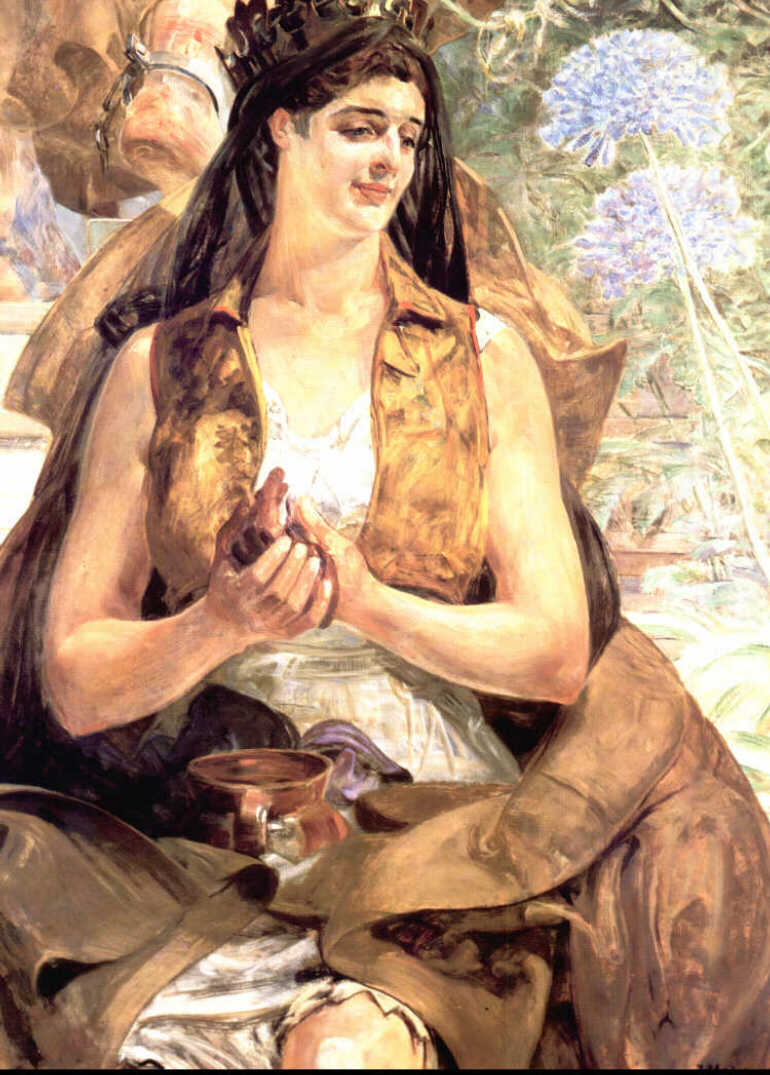
oil, canvas, 137 x 108 cm;
signed p.g.: Olga Boznańska;

Portrait of a man against a landscape background, 1920
oil, canvas, 60,5 x 95 cm;
signed lower right: J.Malczewski 1920;

oil, canvas, 60,5 x 95 cm;
signed lower right: J.Malczewski 1920;

Portrait of Józef Piłsudski
National Museum in Warsaw;
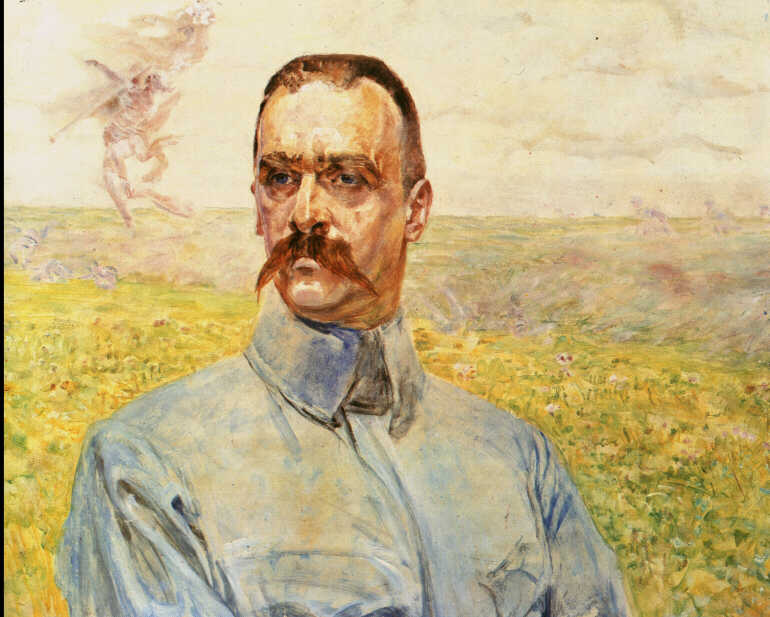
National Museum in Warsaw;

Melancholia
National Museum in Warsaw;

National Museum in Warsaw;

Fall song, portrait of Włodzimierz Lipoński, 1903
oil, cardboard, 46,7 x 62 cm;
signed lower left: J.Malczewski 1906;

oil, cardboard, 46,7 x 62 cm;
signed lower left: J.Malczewski 1906;

Happening songs, portrait of Adam Asnyk, 1899
oil, cardboard, 98 x 77 cm;
signed lower right: J.Malczewski 99;
National Museum in Warsaw;
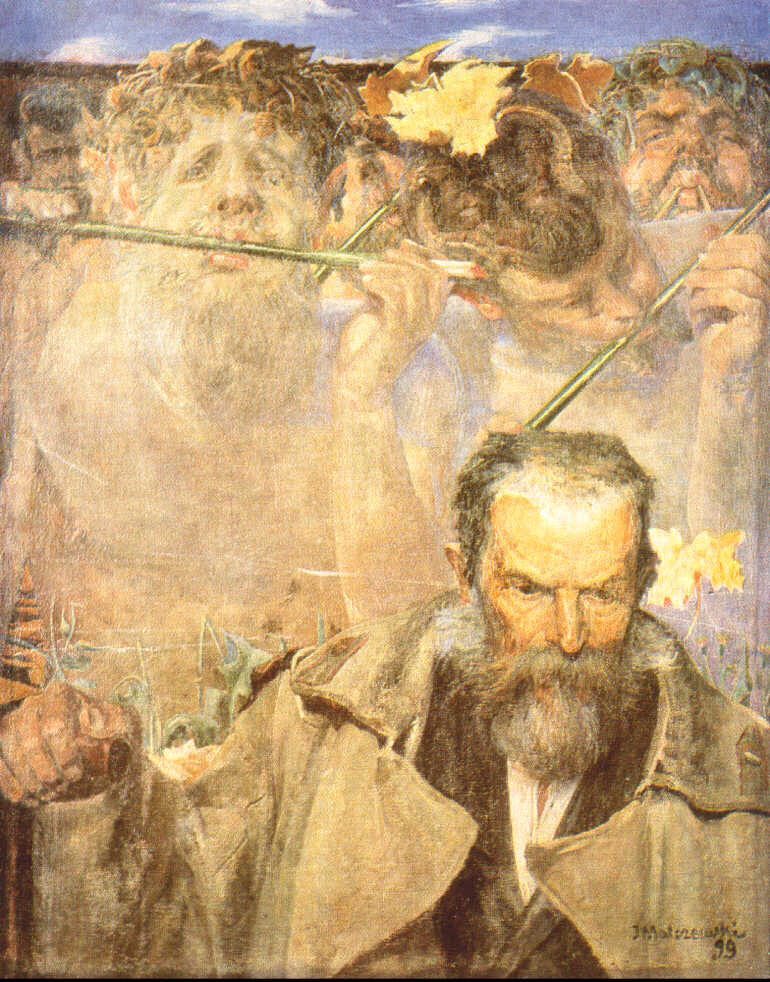
oil, cardboard, 98 x 77 cm;
signed lower right: J.Malczewski 99;
National Museum in Warsaw;

Portrait of Antoni Lanckoroński with his wife
oil, canvas, 60 x 100 cm;
Lviv Picture Gallery;
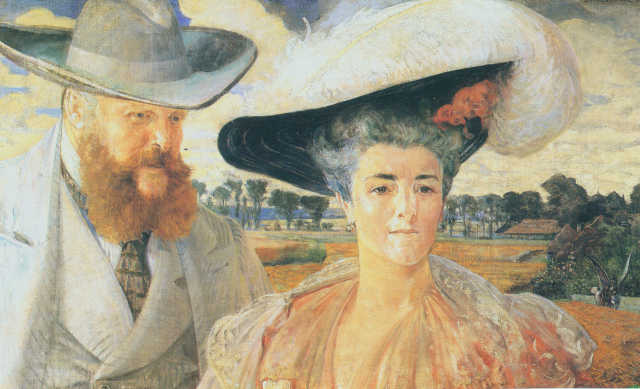
oil, canvas, 60 x 100 cm;
Lviv Picture Gallery;

Knight and fauna
oil, canvas, 182 x 122 cm;
Lviv Picture Gallery;
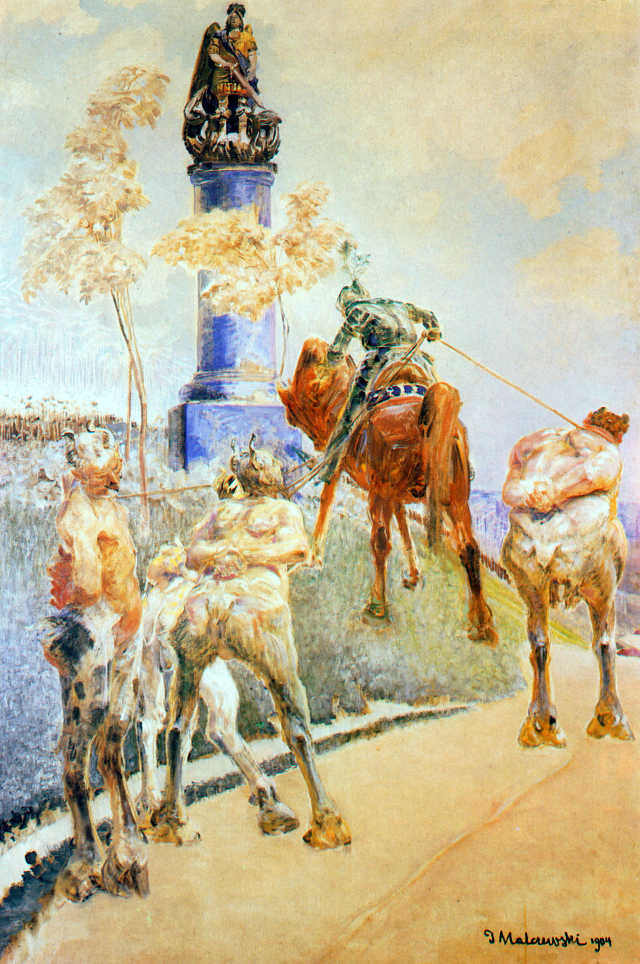
oil, canvas, 182 x 122 cm;
Lviv Picture Gallery;

Elo
oil, canvas, 205,5 x 129 cm;
Lviv Picture Gallery;

oil, canvas, 205,5 x 129 cm;
Lviv Picture Gallery;

Christ before Pilate
oil, cardboard, 65 x 80,5 cm;
Lviv Picture Gallery;
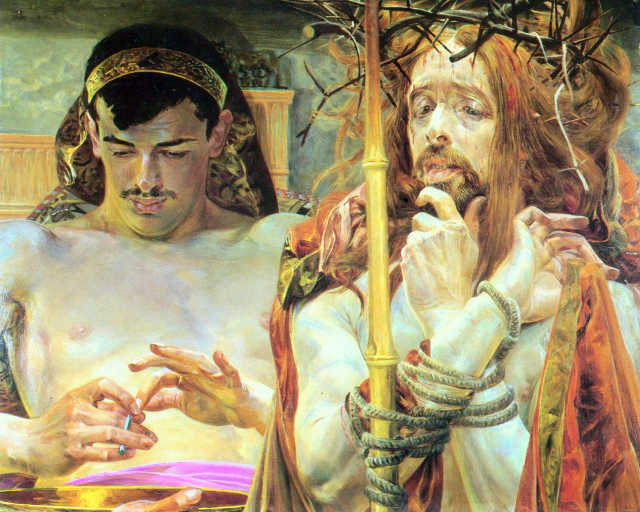
oil, cardboard, 65 x 80,5 cm;
Lviv Picture Gallery;

Bachantka – study of a woman
oil, cardboard, 80,5 x 64,5 cm;
Lviv Picture Gallery;

oil, cardboard, 80,5 x 64,5 cm;
Lviv Picture Gallery;

Portrait of Leon Piniński
oil, cardboard, 40,5 x 32,4 cm;
Lviv Picture Gallery;

oil, cardboard, 40,5 x 32,4 cm;
Lviv Picture Gallery;

Women raking hay
oil, canvas, 59,8 x 100 cm;
Lviv Picture Gallery;
oil, canvas, 59,8 x 100 cm;
Lviv Picture Gallery;


